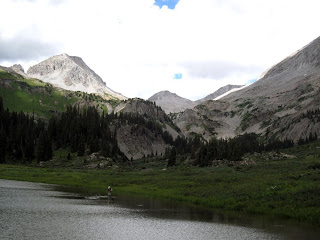 |
| Storm builds over Mt. Sopris in Colorado |
It was late summer in the Elk Mountains of Central Colorado. My girlfriend and I were camped along the shores of beautiful Geneva Lake on the southwestern side of Snowmass Mountain. It was the third night of an eight-day backpack trip in the Snowmass-Maroon Bells Wilderness Area. Our plan had been to hike a convoluted variation of the popular “Four Pass Loop” culminating with an ascent of 14,092’ Snowmass Mountain, one of Colorado’s fifty-three fourteeners. So far the trip had been a success. Starting at Maroon Lake we had hiked for two days, surmounting both Maroon and Frigid Air Passes (both 12,500’) without difficulty. After camping the second night just upstream from Kings Falls, we had spent much of day three exhaustingly circumnavigating a treacherous section of blown-down trees where the usually well-defined trail vanished under head-high piles of hewn lumber. After diligently working our way around this obstacle and climbing a thousand feet towards Trail Rider Pass, we departed from the standard Four Pass Loop for a short detour to Geneva Lake.
We arrived at this alpine oasis with barely enough energy to cook a small meal and collapse in the luxurious embrace of the backpacking hammocks we’d hauled all this way. The sky was clear and pristine that evening as we watched the sunset cast glorious hues of red and orange over the purple slopes of Snowmass Mountain. There was no hint of the storm that would befall us that night.
*
 |
| Storm approaching Geneva Lake |
The raw, sudden violence of lightning and the random way it selects its victims is unnerving to say the least. As an underclassman in college I’d taken Weather and Climate to fulfill a science requirement and we’d read a chapter on fulminology, the study of lightning. I’d seen the ultra slow-motion videos of lightning strikes, and I’d read the science. A cloud-to-ground lighting strike begins with “leaders” moving downward in a forked pattern from a towering cumulus cloud at speeds nearing 150,000 miles per hour. When the first leader connects with the ground the earth and sky undergo an ionic exchange of 300,000 amps of electricity, warming the air in the immediate vicinity to 35,000 degrees Fahrenheit. Around 50 people are killed in the United States each year from lightning, making it second only to flooding as nature’s most deadly threat. Lightning demands and deserves respect.
In the backcountry it is hard to escape the menace of a powerful thunderstorm. In his famous guidebook Colorado’s Fourteeners, Gerry Roach states, “Colorado is famous for apocalyptic lightning storms that threaten not just your life, but your soul as well.” Although there are supposed techniques for minimizing this physical and (apparently) spiritual threat, it is hard not to feel vulnerable when the raw violence of such a tempest is unleashed around you. On July 21, 2010 sixteen people were struck by lightning, one fatally, in a single afternoon on Wyoming’s Grand Teton. I can only imagine (though I don’t really want to) what such a day might have been like. It must have been apocalyptic indeed.
We lay sleepless through the night, listening to the terrible violence of storm after storm bearing down on our little camp. Every time it seemed it had passed the distant rumbles of thunder approaching from the west would begin all over. Like the footsteps of Titans, the booms would get closer, casting resonant echoes off the tall mountain cirque to our east. The bright juxtaposition of lightning in the night’s blackness penetrated eyelids and sleeping bags. There was no hiding and no escape. So I did what any sane person would do when they realized that not only was the apocalypse real but upon them: I prayed. And if I had seen two of every animal floating past, I would have prayed even harder.
As my girlfriend and I lay sleepless, imploring God not to allow the next “leader” to reach its fateful hand our direction, I couldn’t help but comb these facts from my brain, evaluating our current situation in terms what I new about the danger of lightning. More than once, as I lay there gauging how much camping lakeside near treeline increased our odds of electrocution, I longed for the comfort of home. There I could watch a storm such as this through a window with detached fascination and not with the utter terror I felt now.
 |
| Towards Snowmass Mountain from Geneva Lake |
With the peace and serenity of the Colorado backcountry restored, I no longer longed for the comforts of home. The primal nature of the nature is why we venture out into the wild. We go there to be reminded of a world that is much greater and more powerful than the world we wrap around ourselves back in “reality”. Perhaps sometimes we need to be made vulnerable to truly appreciate the frailty of our lives. While this humbling realization may not be enough for me to fully embrace the apocalyptic Colorado thunderstorms, I take solace at least in the fact that once the storm passes my soul and my appreciation for the power of this great world will only be stronger.
NOTE: this article first appeared in print in Our Backyard and on their website.
Visit THE ARCHIVE: A list of most of our articles sorted by department

No comments:
Post a Comment